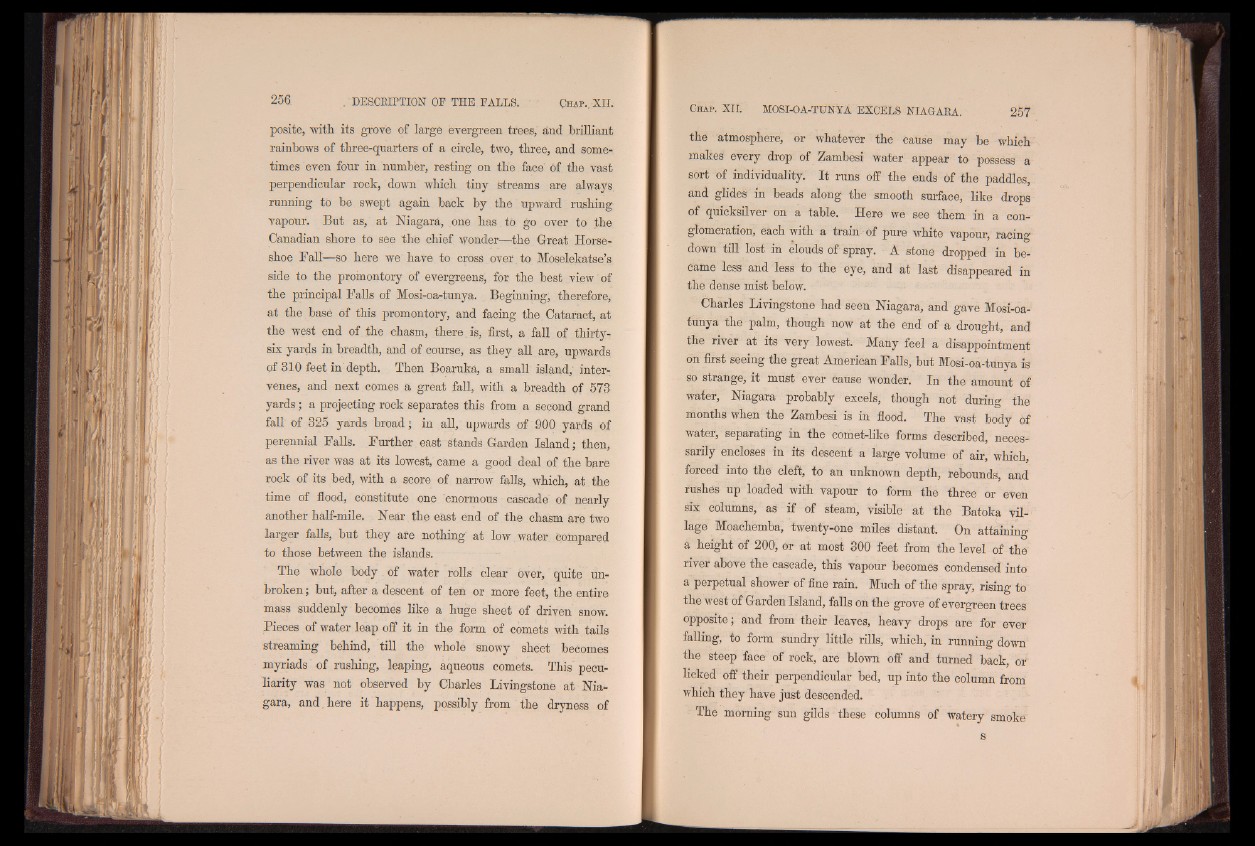
posite, with its grove of large evergreen trees, and brilliant
rainbows of three-quarters of a circle, two, three, and sometimes
even four in. number, resting on the face' 6f the vast
perpendicular rock, down which tiny streams are always,
running to be swept again back by the upward rushing
vapour. But as, at Niagara, one has . to go over to the
Canadian shore to see the chief wonder—the Great Horseshoe
Fall—so here we have to cross over to Moselekatse’s
side to the promontory of evergreens, for the best view of
the principal Falls of Mosi-oa-tunya. Beginning, therefore,
at the base of this promontory, and facing the Cataract, at
the west end of the chasm, there,is, first, a fall of thirty-
six yards in breadth, and of course, as they all are, upwards
of 310 feet in depth. Then Boaruka, a small island; intervenes,
and next comes a great fall, with a breadth of 573
yards; a projecting rock separates this from a second grand
fall of 325 yards broad; in all, upwards of 900 yards of
perennial Falls. Further east stands Garden Island; then,
as the river was at its lowest, came a good deal of the bare
rock of its bed, with a score of narrow falls, which, at the
time of flood, constitute one enormous cascade' of nearly
another half-mile. Near the east, end of the chasm are two
larger falls, but they are nothing at low water compared
to those between the islands.
The whole body of water rolls clear over, quite unbroken
; but, after a descent of ten or more feet, the entire
mass suddenly becomes like a huge sheet of driven snow.
Pieces of water leap off it in the form of comets with tail«
streaming behind, till the whole snowy sheet becomes
myriads of rushing, leaping, aqueous comets. This peculiarity
was not observed by Charles Livingstone at Niagara,
and . here it happens, possibly from the dryness of
the atmosphere, or whatever the cause may be which
makes every drop of Zambesi water appear to possess a
sort of individuality. It runs off the ends of the paddles,
and glides m beads along the smooth surface, like drops
of quicksilver on a table. Here we see them in a conglomeration,
each with a train of pure white vapour, racing
down till lost in clouds of spray. A stone dropped in became
less and less to the eye, and at last disappeared in
the dense mist below.
Charles Livingstone had seen Niagara, and gave Mosi-oa-
tunya the palm, though now at the end of a drought, and
the river at its very lowest. Many feel a disappointment
on first seeing the great American Falls, but Mosi-oa-tunya is
so strange, it must ever cause wonder. In the amount of
water, Niagara probably excels, though not during the
months when the Zambesi is in flood. The Vast body 6f
water, separating in the comet-like forms described, necessarily
encloses in its descent a large volume of air, which,
forced into the cleft, to an unknown depth, rebounds, and
rushes up loaded with vapour to form the three or even
six columns, as if of steam, visible at the Batoka village
Moachemba, twenty-one miles distant. On attaining
a height of 200, or at most 300 feet from the level of the
river above the cascade, this vapour becomes condensed into
a perpetual shower of fine rain. Much of the spray, rising to
the west of Garden Island, falls on the grove of evergreen trees
opposite; and from their leaves, heavy drops are for ever
falling, to form sundry little rills, which, in running down
the steep face of rock, are blown off and turned back, or
licked off their perpendicular bed, up into the column from
which they have just descended.
The morning sun gilds these columns of watery smoke